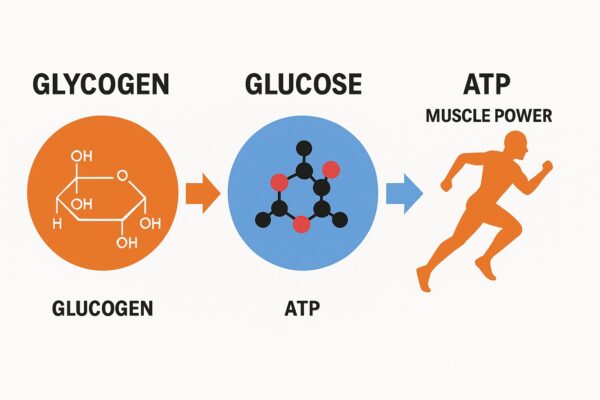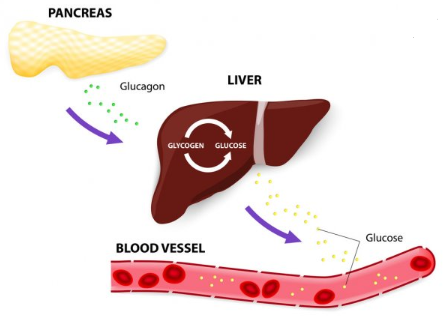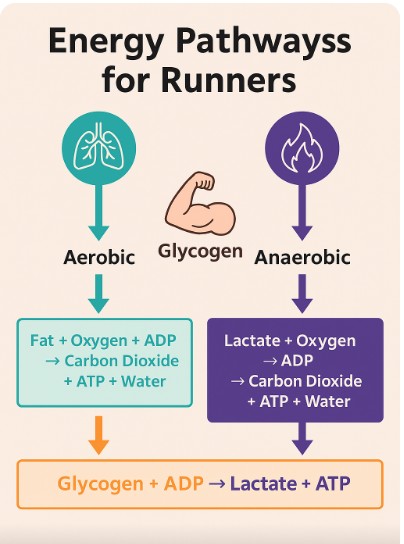I’ll never forget the wall I hit during one of my first marathons. Somewhere around 35 km, my legs turned heavy, my breathing ragged. That’s when I truly understood the importance of fuel—specifically, glycogen. In the years since, I’ve learned that understanding how your body stores and uses glycogen can transform your training and your race day performance. Let’s dive into the story behind this powerful energy source—and how it can carry you all the way to the finish line.
An illustrated process of how glycogen become to muscle power here:

🦵 What Is Glycogen, Really? A Runner’s Best Friend
You’ve probably heard of glycogen in passing—maybe during a carb-loading chat. But here’s the truth: glycogen is your body’s primary energy reserve during endurance exercise. Think of it as your internal battery, charged every time you eat carbohydrates.
When you eat a bowl of pasta the night before your long run, your body breaks down those carbs into glucose, then stores them in your liver and muscles as glycogen. Come race day, your muscles tap into those stores to keep you going. Without enough glycogen? You bonk. It’s that simple—and that important.
Here is an illustration of the glycogen process in the body:

📈 Why Intensity Affects Fuel: The Oxygen Factor
Here’s where it gets a bit science-y—but don’t worry, I’ll keep it real. When you run at a steady, moderate pace, your body uses aerobic energy, meaning it uses oxygen to burn both fat and glycogen. This is the sweet spot for long-distance running.
But if you speed up—maybe in a race surge or final sprint—you dip into anaerobic energy, where glycogen becomes your main (and almost only) fuel source because oxygen can’t keep up.
🔥 Personal Note:
In my third marathon, I went out too fast. By 30 km, I felt the burn—the infamous lactic acid buildup. My glycogen was depleting rapidly because I wasn’t pacing for oxygen balance. Lesson learned: pace matters just as much as fueling.
🔬 How Glycogen Powers Every Stride
Let’s break it down simply:
-
Your muscles convert glycogen to glucose
-
Glucose feeds into a process that regenerates ATP (adenosine triphosphate)—your body’s real energy currency
-
ATP powers your muscle contractions
Here’s the catch: ATP is limited. Your body can only store enough for about 2 seconds of effort. That’s why your body constantly regenerates it using glycogen (and fat, when possible).
The process is illustrated in the Infographic here:

And here’s the science behind your stride:
🔁 ATP → ADP + Energy
This reaction powers your muscle contractions. But since ATP stores are tiny (enough for just 2 seconds!), your body must re-form ATP constantly to keep moving.That regeneration comes from glycogen and fat, depending on oxygen availability. During aerobic runs, glycogen is converted efficiently:
✅ “Fat + Oxygen + ADP → Carbon dioxide + ATP + Water”
✅ “Glycogen + Oxygen + ADP → Carbon dioxide + ATP + Water”
These are the clean burn fuels—where your body produces water and CO₂, which it expels through sweat and breath. That’s the magic of endurance.
When you sprint or run uphill and oxygen can’t keep up, your muscles shift into anaerobic mode:
✅ “Glycogen + ADP → Lactate + ATP”
That lactate can be recycled later, once oxygen is available:
✅ “Lactate + Oxygen + ADP → Carbon dioxide + ATP + Water”
That’s why it’s crucial to pace yourself during long runs—to stay in that aerobic zone where your body can efficiently recycle lactate and avoid the burn.
🧬 Enzymes: The Unsung Heroes of Endurance
Glycogen’s conversion to usable energy relies on special enzymes in your muscle fibers. The more trained you are, the more efficient these enzymes become. That means:
-
You use glycogen more slowly
-
You get more energy per gram
-
You delay fatigue longer
In muscle fibers, enzymes act like silent workhorses, speeding up energy conversion. These proteins regulate the chemical reactions that transform glycogen and fat into usable fuel. The more you run, the more efficient these enzymes become.
✅ “Through specific enzymes, the individual muscle fiber is able to optimize and regulate energy conversion.”
When trained, your muscles increase both the number and activity of enzymes responsible for breaking down glycogen and fat. As your aerobic fitness improves, your body becomes better at maximizing energy production.
Training Tip:
Consistent aerobic runs build up these enzymes over time. Miss a few weeks, and they decline quickly. That’s why base building and maintenance runs are vital—even in the off-season.
🛠️ Fueling Smart: How to Protect Your Glycogen Stores

-
Pre-run: Eat complex carbs 24–48 hours before your long run.
-
During your run: Use glucose gels or sports drinks every 30–45 minutes to avoid depleting your glycogen too fast.
-
Post-run: Refuel with a mix of carbs and protein to replenish glycogen and aid muscle repair.
Personal Story:
Before a marathon, I started practicing mid-run fueling every Sunday. At first, I hated gels—they felt gooey and weird. But then I noticed my pace held steady past mile 20. I wasn’t bonking. I was finishing strong.
During the first few minutes of your run, your aerobic systems aren’t fully active. So your body temporarily uses anaerobic pathways, producing lactate. But don’t worry—it stabilizes quickly:
✅ “When we start our running, it will take a few minutes before our aerobic systems activate… the lactate will quickly disappear when the aerobic processes start up.”
This is normal. That’s why warming up and pacing slowly into your long runs is so helpful—it gives your body time to switch gears into efficient, oxygen-based energy use.
⚖️ Glycogen vs. Fat: Who’s in Charge?
Let’s be clear: Your body uses both fat and glycogen for fuel.
But fat burns slower and requires more oxygen. Glycogen burns faster—perfect for steady endurance running where energy demands are high but still aerobic.
Why it matters for you:
When glycogen runs out, your body shifts to fat—but that switch feels like hitting a wall. Training helps you push that wall further out.
❓Frequently Asked Questions About Glycogen and Marathon Running
Why do marathon runners need glycogen?
Glycogen is your body’s go-to energy reserve when you’re running at moderate to high intensity. It fuels your muscles efficiently, helping you maintain pace and power over long distances. Without it, you risk “hitting the wall”—a dramatic drop in energy that can bring even the best-prepared runner to a crawl.
How do you replenish glycogen during a marathon?
To keep your glycogen stores from crashing, it’s smart to fuel as you go. Most runners use glucose-based energy gels, chews, or sports drinks. Taken every 30–45 minutes during the race, these fast-absorbing carbs help you stay energized and avoid mid-run bonking.
How can you preserve glycogen for the marathon?
It’s all about strategy. First, make sure to carb-load 24–48 hours before race day to maximize your glycogen stores. During the race, pace yourself to stay within your aerobic zone, where your body can also use fat as fuel. And don’t forget mid-run carbs—they help spare your precious glycogen.
How long does it take to run out of glycogen?
Glycogen typically lasts for about 90 to 120 minutes of steady running, though this varies depending on your pace, fitness, and how well you’ve fueled. That’s why many runners start to feel drained between miles 18 and 22 of a marathon—classic signs of glycogen depletion.
🏁 Final Thoughts: Run With Your Fuel, Not Against It
Understanding glycogen changed the way I run. It’s no longer just about logging miles—it’s about preparing my body to access energy when it matters most. If you’re training for your first marathon or your fifteenth, give your glycogen stores the love and attention they deserve. They might just be the difference between finishing strong… and crawling to the line.
🗣️ Leave a Comment
Have you ever hit the wall mid-race? Or found a fueling strategy that worked wonders for you? I’d love to hear your experience!
👇 Share your thoughts, questions, or tips in the comments below—let’s support each other on the road to stronger, smarter running.
💬 Your story might inspire someone else’s next breakthrough.





